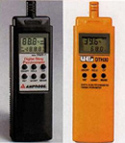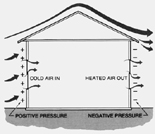
Figure 1. This is a photo of a cabinet door that is showing shrinkage due to low humidity. (Click on the image for an enlarged view.)
She explained that the painted surfaces on some of her cabinets were shrinking to the point that she could see the unpainted surfaces (Figure 1).
Bob looked around the house and could see signs of wood shrinkage in several places. He was standing there scratching his head when Btu Buddy made an appearance and asked, “What is the problem, Bob?”
Bob said, “Boy am I glad to see you. This house is so dry that the wood is drying up and shrinking. I have never noticed that before, until the homeowner showed it to me. I don’t know why a house would be so dry.”

Figure 2. 2-A (above) shows an older sling psychrometer; 2-B (below) shows newer electronic instruments for taking humidity readings. (Figure is from Refrigeration & Air Conditioning Technology, 5th Edition, by William Whitman, William Johnson, and John Tomczyk, published by Delmar Cengage Learning.)
Bob said, “No, but I can take a reading and find out.”
Bob went to the truck and brought in his sling psychrometer (Figure 2) and took some readings. He then said, “This house is very dry; the humidity is down to about 15 percent. What should the humidity be?”
Btu Buddy said, “Most people in the industry would like to hold the humidity somewhere between 40 percent and 60 percent for a typical home. Below 40 percent is uncomfortable and the wood in the house will begin to suffer. If the humidity is above 60 percent, mold can grow in some places in the house.”
Bob then said, “I wonder why the humidity in this home is so low.”

Bob then asked, “How in the world can that much air change out in a house? It would seem like it would be like a wind tunnel.”

Figure 3. An excerpt from a psychrometric chart showing air entering at 35°F and 50 percent humidity mixing with air in the home at 70° and the humidity of that air dropping to 19 percent. (Figure is from Practical Cooling Technology by William Johnson, published by Delmar Cengage Learning.) (Click on the image for an enlarged view.)
Bob then asked, “Now what do we do?”
Btu Buddy then suggested, “I think you should show the owner what is going on with the structure and suggest that she get a contractor to offer suggestions. Your company can explore and repair some of the problems. The air distribution duct system can also cause excess outdoor air to be pulled into the structure. If the supply duct leaks, the return air will cause the home to go into a slight vacuum, sucking in outdoor air. If the return duct leaks, it will suck in outdoor air from either under the house or the attic when the duct is routed in these locations. This will force air into the structure and put it into a positive pressure. You can check those yourself and instigate a repair. Meanwhile, you can install a humidifier in the central duct system and a humidistat to help stabilize the humidity in the house.”

Figure 4. This illustration shows how infiltration air enters a structure from the prevailing breezes. (Figure is from Practical Heating Technology by William Johnson, published by Delmar Cengage Learning.) (Click on the image for an enlarged view.)
Bob found several places in the supply duct that needed attention. He also applied mastic to all of the duct connections that he could access. He then turned his attention to the return duct and found several places where it was obvious that air was leaking in and repaired them. He then called the company and asked for a duct pressure test technician to come out and test the duct for leaks. They did this by taping all duct outlets and returns and applied a fan to the furnace fan section and pulled room air into the duct system pressurizing it. They then measured the amount of leakage and told Bob that he had done a good job of sealing the system. It had very little leakage.
Meanwhile, a contractor showed up and Bob explained what was going on. The contractor looked around and suggested to the homeowner that she had storm windows that were not great, but adequate. He looked under the sinks on the outside walls and suggested that all penetrations to the home be sealed, including plumbing and electrical (Figure 4). He explained to her that it would take a few materials and only a few hours to complete this job.
Bob then said, “Now for the big question: What type of humidifier should we use?”
Btu Buddy responded, “That is a big question. You are not going to install it today. Let’s go to lunch and explore that topic with some research.”
Bob said, “Well, this simple job turned into a learning experience, but I love it.”
Publication date:02/16/2009


Report Abusive Comment